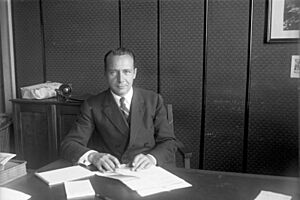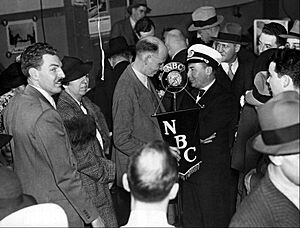Ernst A. Lehmann facts for kids
Quick facts for kids
Ernst August Lehmann
|
|
|---|---|
 |
|
| Born | 12 May 1886 |
| Died | 7 May 1937 (aged 50) |
| Cause of death | Injuries sustained in the Hindenburg disaster |
| Nationality | German |
Captain Ernst August Lehmann (born May 12, 1886 – died May 7, 1937) was a famous German Zeppelin captain. He was known as one of the most experienced people in German airship travel. Some even called him the best airship pilot in the world. However, he was sometimes criticized for making risky moves with the airships.
Sadly, he was a victim of the famous Hindenburg disaster in 1937.
Contents
Early Life and Training
Ernst Lehmann was born in 1886 in a town called Ludwigshafen am Rhein in Germany. When he was 14, he decided he wanted to build ships. He studied engineering at the Technische Hochschule Berlin and finished his degree in 1912. By this time, he had also joined the navy and became a naval reserve lieutenant.
After graduating, he started working at the Imperial Dockyards in Kiel. But he didn't find this work very exciting. So, with encouragement from Dr. Hugo Eckener, he joined a company called DELAG. There, he became a pilot for the passenger airship LZ 17 Sachsen. He flew this airship 550 times!
Airship Service During World War I
During the First World War, Captain Lehmann commanded airships for both the army and the navy. He started with the Sachsen after the army took it over. Then he commanded other airships like the LZ XII, LZ 90, LZ 98, and LZ 120. He was a key figure in airship operations during the war.
Commercial Airship Travel After the War
After the war, Captain Lehmann continued to work with airships, which were now used for civilian travel again. He planned to fly the naval airship L 72 on the first transatlantic crossing by an airship in 1919. However, the German government did not allow it.
In 1921, he spent four months in the United States. He was preparing for a planned airship route between New York and Chicago. In 1922, he tried to set up a route across the North Atlantic Ocean with the United States and England.
In 1923, the Goodyear Zeppelin Corporation was created. Captain Lehmann became the Vice President in charge of engineering for this company. In 1924, Captain Lehmann was second-in-command of the LZ 126. This airship made the first nonstop transatlantic flight between Europe and America. The flight's goal was to deliver the Zeppelin to its new owners, the United States Navy. They renamed the ship USS Los Angeles.
In 1935, a new airline called Deutsche Zeppelin Reederei was formed. This was done to increase the influence of the Nazi government over zeppelin operations. Captain Lehmann was named the director of this new airline.
Captain Lehmann was the commanding officer for over 100 flights of the Graf Zeppelin between 1928 and 1936. In 1936, he commanded 10 round-trip flights to Lakehurst on the new Hindenburg. Captain Lehmann was also a talented accordion player. He often played music for passengers on long flights, including pieces by Wagner and German folk songs.
The Hindenburg Disaster
On May 6, 1937, Captain Lehmann was on board the Hindenburg during its last flight. Although Max Pruss was the main commanding officer, Captain Lehmann was the most senior officer present, acting as an observer.
When the airship caught fire in Lakehurst, New Jersey, Captain Lehmann was badly burned. He died the next day, on May 7, 1937, from his injuries. At the time of his death, he seemed to believe that the Hindenburg had been sabotaged. He was heard saying, "I don't understand it."
Books by Captain Lehmann
Captain Lehmann wrote several books about his experiences with airships. His first book in English was called The Zeppelins: The Development of the Airship, with the Story of the Zeppelin Air Raids in the World War. It was published in 1927.
He also wrote about his personal experiences as a zeppelin captain in war and peace in a German book.
Captain Lehmann's last book, Zeppelin: The Story of Lighter-than-air Craft, was being translated into English. The translator, Leonhard Adelt, was actually on board the Hindenburg with Lehmann during its final flight. The English translation was finished by Jay Dratler and published later in 1937. It included a special introduction and closing chapter by American airship captain Charles E. Rosendahl, who had spoken with Lehmann before he died.
Images for kids



